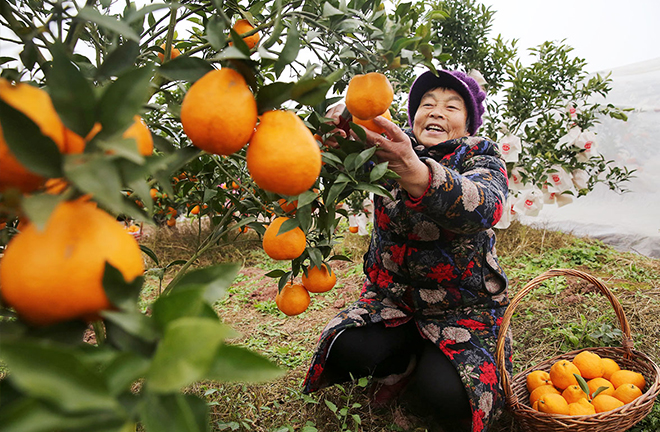China still faces tough task of relative poverty alleviation

A farmer picks oranges at an agricultural base for poverty alleviation project in Gaowu Village of Shuangcai Town, Neijiang City, Sichuan Province. Photo: Lan Zitao/CNSphoto
By December 2020, China had accomplished its goal of fighting against poverty in the new era according to schedule. All impoverished counties nationwide have been lifted out of poverty, while absolute poverty and overall regional poverty have been eliminated. Nearly 100 million poor people succeeded in eradicating poverty and this major victory has been lauded worldwide.
However, the elimination of absolute poverty does not mean the end of governance focused on poverty. Relative poverty will remain for a long time.
While absolute poverty has been eradicated through institutional advantages, the government's tasks related to poverty in China have transitioned. Resolving the problem of relative poverty has become the main work for poverty governance in China. A comparison between these two types of poverty governance shows that relative poverty governance has a broader scope. First, the targeted objectives for relative poverty are pluralistic, including structural low-income populations, potentially poor populations, poor populations with low earning capacity, and those who occasionally return to poverty. Second, the standard of governance for relative poverty is not fixed. Different from the relatively fixed standard of governance for absolute poverty, relative poverty transcends the objectivity of material conditions, and is evaluated by benchmarks with comparisons between groups. Third, elements involved in relative poverty governance are complex, and include economic, technical, cyclical, and structural elements. Finally, relative poverty governance has multiple tasks: to prevent the return to poverty and the rise of new poverty; to ensure that poverty alleviation in urban and rural areas is implemented evenly; to narrow the income distribution gap; and to eradicate poverty on multi-dimensional levels. Therefore, in exploring a long-term mechanism that resolves relative poverty, the following three aspects are noteworthy.
Above all, systems must be improved concerning poverty alleviation. Since the 18th National Congress of the Communist Party of China (CPC), China has established a set of poverty battling systems with Chinese characteristics, including responsibility systems, policy systems, input systems, aid systems, social mobilization systems, supervision systems and assessment systems. Since the long-term mechanism to alleviate relative poverty is essentially about such issues as the flow of factors of production, wealth distribution, and social security, a multi-dimensional poverty alleviation system is needed.
The next goal is to build an identifying mechanism for relative poverty. In the post-poverty alleviation era, absolute poverty which is easy to directly evaluate has transformed into relative poverty, which is much more difficult to discover and discern. Large-scale regional poverty, which once mainly struck rural areas, has transformed into a decentralized individual form of poverty which covers both urban and rural areas, and the identification of this type of poverty has become more covert and variable. Populations facing relative poverty can be divided into four groups: those who enjoy basic living guarantees but with low-income; those who still linger on the edge of poverty after being lifted out of absolute poverty; those with low earning capacity and whose initiatives and motivations for pursuing a better life are lost; and those who have returned to poverty because of a natural disaster, unemployment, or an accident. To scientifically identify populations who face relative poverty, the threshold for relative poverty can be established first and then dual data—small and big data—can be adopted for targeting and identification. By uploading the individual's information and applying data analysis based on epidemiological investigation, groups approaching relative poverty can be identified by means of modern technology. After identifying these groups, an information database which is adjusted in real-time and dynamically updated, can be set up to monitor and aid the group.
Finally, institutional advantages can be released by attaining three goals. The first is to break the barriers of urban-rural dual structure and equalize basic public services between urban and rural areas. The second is to further improve the efficiency of land resource allocation, stimulate agricultural production, and pursue intensive and efficient agricultural production models. The third is to further enhance the modernization of national governance systems and governance capacities, and boost relative poverty governance through coordinated efforts from government, market, and society.
Yuanwei and Ji Zhengju are respectively from the School of Marxism at Henan University and Economic Daily Press.
Edited by BAI LE
